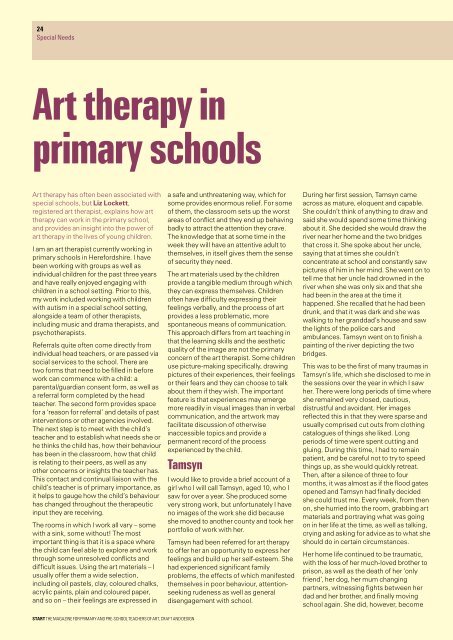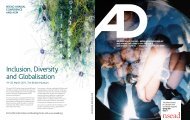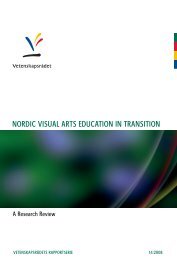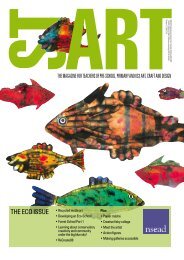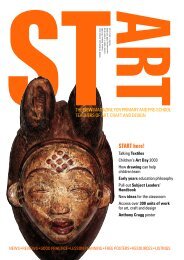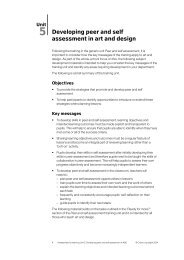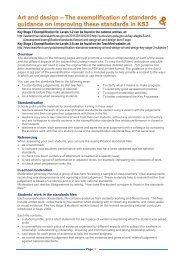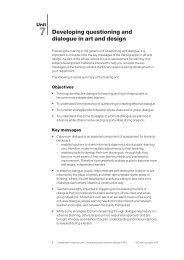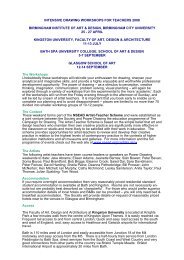textiles issue - The National Society for Education in Art and Design
textiles issue - The National Society for Education in Art and Design
textiles issue - The National Society for Education in Art and Design
You also want an ePaper? Increase the reach of your titles
YUMPU automatically turns print PDFs into web optimized ePapers that Google loves.
24Special Needs25Special Needs<strong>Art</strong> therapy <strong>in</strong>primary schools‘<strong>Art</strong> therapy … can work <strong>in</strong>conjunction with <strong>and</strong> <strong>in</strong>deedfacilitate the educationalprocess.’<strong>Art</strong> therapy has often been associated withspecial schools, but Liz Lockett,registered art therapist, expla<strong>in</strong>s how arttherapy can work <strong>in</strong> the primary school,<strong>and</strong> provides an <strong>in</strong>sight <strong>in</strong>to the power ofart therapy <strong>in</strong> the lives of young children.I am an art therapist currently work<strong>in</strong>g <strong>in</strong>primary schools <strong>in</strong> Here<strong>for</strong>dshire. I havebeen work<strong>in</strong>g with groups as well as<strong>in</strong>dividual children <strong>for</strong> the past three years<strong>and</strong> have really enjoyed engag<strong>in</strong>g withchildren <strong>in</strong> a school sett<strong>in</strong>g. Prior to this,my work <strong>in</strong>cluded work<strong>in</strong>g with childrenwith autism <strong>in</strong> a special school sett<strong>in</strong>g,alongside a team of other therapists,<strong>in</strong>clud<strong>in</strong>g music <strong>and</strong> drama therapists, <strong>and</strong>psychotherapists.Referrals quite often come directly from<strong>in</strong>dividual head teachers, or are passed viasocial services to the school. <strong>The</strong>re aretwo <strong>for</strong>ms that need to be filled <strong>in</strong> be<strong>for</strong>ework can commence with a child: aparental/guardian consent <strong>for</strong>m, as well asa referral <strong>for</strong>m completed by the headteacher. <strong>The</strong> second <strong>for</strong>m provides space<strong>for</strong> a ‘reason <strong>for</strong> referral’ <strong>and</strong> details of past<strong>in</strong>terventions or other agencies <strong>in</strong>volved.<strong>The</strong> next step is to meet with the child’steacher <strong>and</strong> to establish what needs she orhe th<strong>in</strong>ks the child has, how their behaviourhas been <strong>in</strong> the classroom, how that childis relat<strong>in</strong>g to their peers, as well as anyother concerns or <strong>in</strong>sights the teacher has.This contact <strong>and</strong> cont<strong>in</strong>ual liaison with thechild’s teacher is of primary importance, asit helps to gauge how the child’s behaviourhas changed throughout the therapeutic<strong>in</strong>put they are receiv<strong>in</strong>g.<strong>The</strong> rooms <strong>in</strong> which I work all vary – somewith a s<strong>in</strong>k, some without! <strong>The</strong> mostimportant th<strong>in</strong>g is that it is a space wherethe child can feel able to explore <strong>and</strong> workthrough some unresolved conflicts <strong>and</strong>difficult <strong>issue</strong>s. Us<strong>in</strong>g the art materials – Iusually offer them a wide selection,<strong>in</strong>clud<strong>in</strong>g oil pastels, clay, coloured chalks,acrylic pa<strong>in</strong>ts, pla<strong>in</strong> <strong>and</strong> coloured paper,<strong>and</strong> so on – their feel<strong>in</strong>gs are expressed <strong>in</strong>a safe <strong>and</strong> unthreaten<strong>in</strong>g way, which <strong>for</strong>some provides enormous relief. For someof them, the classroom sets up the worstareas of conflict <strong>and</strong> they end up behav<strong>in</strong>gbadly to attract the attention they crave.<strong>The</strong> knowledge that at some time <strong>in</strong> theweek they will have an attentive adult tothemselves, <strong>in</strong> itself gives them the senseof security they need.<strong>The</strong> art materials used by the childrenprovide a tangible medium through whichthey can express themselves. Childrenoften have difficulty express<strong>in</strong>g theirfeel<strong>in</strong>gs verbally, <strong>and</strong> the process of artprovides a less problematic, morespontaneous means of communication.This approach differs from art teach<strong>in</strong>g <strong>in</strong>that the learn<strong>in</strong>g skills <strong>and</strong> the aestheticquality of the image are not the primaryconcern of the art therapist. Some childrenuse picture-mak<strong>in</strong>g specifically, draw<strong>in</strong>gpictures of their experiences, their feel<strong>in</strong>gsor their fears <strong>and</strong> they can choose to talkabout them if they wish. <strong>The</strong> importantfeature is that experiences may emergemore readily <strong>in</strong> visual images than <strong>in</strong> verbalcommunication, <strong>and</strong> the artwork mayfacilitate discussion of otherwise<strong>in</strong>accessible topics <strong>and</strong> provide apermanent record of the processexperienced by the child.TamsynI would like to provide a brief account of agirl who I will call Tamsyn, aged 10, who Isaw <strong>for</strong> over a year. She produced somevery strong work, but un<strong>for</strong>tunately I haveno images of the work she did becauseshe moved to another county <strong>and</strong> took herportfolio of work with her.Tamsyn had been referred <strong>for</strong> art therapyto offer her an opportunity to express herfeel<strong>in</strong>gs <strong>and</strong> build up her self-esteem. Shehad experienced significant familyproblems, the effects of which manifestedthemselves <strong>in</strong> poor behaviour, attentionseek<strong>in</strong>grudeness as well as generaldisengagement with school.Dur<strong>in</strong>g her first session, Tamsyn cameacross as mature, eloquent <strong>and</strong> capable.She couldn’t th<strong>in</strong>k of anyth<strong>in</strong>g to draw <strong>and</strong>said she would spend some time th<strong>in</strong>k<strong>in</strong>gabout it. She decided she would draw theriver near her home <strong>and</strong> the two bridgesthat cross it. She spoke about her uncle,say<strong>in</strong>g that at times she couldn’tconcentrate at school <strong>and</strong> constantly sawpictures of him <strong>in</strong> her m<strong>in</strong>d. She went on totell me that her uncle had drowned <strong>in</strong> theriver when she was only six <strong>and</strong> that shehad been <strong>in</strong> the area at the time ithappened. She recalled that he had beendrunk, <strong>and</strong> that it was dark <strong>and</strong> she waswalk<strong>in</strong>g to her gr<strong>and</strong>dad’s house <strong>and</strong> sawthe lights of the police cars <strong>and</strong>ambulances. Tamsyn went on to f<strong>in</strong>ish apa<strong>in</strong>t<strong>in</strong>g of the river depict<strong>in</strong>g the twobridges.This was to be the first of many traumas <strong>in</strong>Tamsyn’s life, which she disclosed to me <strong>in</strong>the sessions over the year <strong>in</strong> which I sawher. <strong>The</strong>re were long periods of time whereshe rema<strong>in</strong>ed very closed, cautious,distrustful <strong>and</strong> avoidant. Her imagesreflected this <strong>in</strong> that they were sparse <strong>and</strong>usually comprised cut outs from cloth<strong>in</strong>gcatalogues of th<strong>in</strong>gs she liked. Longperiods of time were spent cutt<strong>in</strong>g <strong>and</strong>glu<strong>in</strong>g. Dur<strong>in</strong>g this time, I had to rema<strong>in</strong>patient, <strong>and</strong> be careful not to try to speedth<strong>in</strong>gs up, as she would quickly retreat.<strong>The</strong>n, after a silence of three to fourmonths, it was almost as if the flood gatesopened <strong>and</strong> Tamsyn had f<strong>in</strong>ally decidedshe could trust me. Every week, from thenon, she hurried <strong>in</strong>to the room, grabb<strong>in</strong>g artmaterials <strong>and</strong> portray<strong>in</strong>g what was go<strong>in</strong>gon <strong>in</strong> her life at the time, as well as talk<strong>in</strong>g,cry<strong>in</strong>g <strong>and</strong> ask<strong>in</strong>g <strong>for</strong> advice as to what sheshould do <strong>in</strong> certa<strong>in</strong> circumstances.Her home life cont<strong>in</strong>ued to be traumatic,with the loss of her much-loved brother toprison, as well as the death of her ‘onlyfriend’, her dog, her mum chang<strong>in</strong>gpartners, witness<strong>in</strong>g fights between herdad <strong>and</strong> her brother, <strong>and</strong> f<strong>in</strong>ally mov<strong>in</strong>gschool aga<strong>in</strong>. She did, however, becomemuch more <strong>in</strong>tegrated <strong>and</strong> happy at hercurrent school dur<strong>in</strong>g the time she wasreceiv<strong>in</strong>g art therapy.Our f<strong>in</strong>al session was difficult <strong>for</strong> us both,as we had been on quite a journeytogether. Tamsyn brought some smallcakes, which we shared, <strong>and</strong> asked if Icould cont<strong>in</strong>ue to see her <strong>in</strong> her newschool <strong>in</strong> Manchester. She knew this wasimpossible, <strong>and</strong> we both understood thatthis was her way of say<strong>in</strong>g she didn’t wantit to end.Primary school arttherapy groupThis is a brief account of an art therapygroup that ran <strong>for</strong> eight weeks at a primaryschool <strong>in</strong> Here<strong>for</strong>dshire. We had twogroups: the first <strong>in</strong>cluded children fromYears 1 <strong>and</strong> 2, <strong>and</strong> the second, those fromYears 3, 4, 5 <strong>and</strong> 6. Each group conta<strong>in</strong>edaround six to eight boys <strong>and</strong> girls of mixedability <strong>and</strong> lasted <strong>for</strong> 45 m<strong>in</strong>utes.<strong>The</strong> aim of the group was to provide an arttherapy group experience that would allow<strong>for</strong> expression of emotion with<strong>in</strong> astructure that was supportive, conta<strong>in</strong><strong>in</strong>g<strong>and</strong> gently challeng<strong>in</strong>g. Many of thechildren had low self-esteem <strong>and</strong> lowconfidence. Others had problems relat<strong>in</strong>gto their peer group, as they found it hard totake turns, share or listen without<strong>in</strong>terrupt<strong>in</strong>g one another, giv<strong>in</strong>g theimpression of a lack of respect <strong>and</strong>thoughtfulness about the needs of others.<strong>The</strong> <strong>in</strong>itial part of the session was spentsitt<strong>in</strong>g together <strong>in</strong> a circle. This gave thegroup time to gather, <strong>and</strong> was usuallyspent do<strong>in</strong>g a warm-up activity, <strong>in</strong>clud<strong>in</strong>g<strong>in</strong>troductions, f<strong>in</strong>d<strong>in</strong>g out how everyone <strong>in</strong>the group was feel<strong>in</strong>g that day, ormovement <strong>and</strong> exercises.<strong>The</strong> second part of the session was usuallyspent around a large table, pa<strong>in</strong>t<strong>in</strong>g. Thiswas often a directive session led by me<strong>and</strong> <strong>in</strong>cluded a variety of themes, <strong>in</strong>clud<strong>in</strong>gpa<strong>in</strong>t<strong>in</strong>g <strong>in</strong> pairs, self-portraits, families,round rob<strong>in</strong> draw<strong>in</strong>gs, emotions, wishes<strong>and</strong> metaphorical gifts to one another.This part of the session gave the childrenan opportunity to be self-expressive, toexperience us<strong>in</strong>g various art materials<strong>and</strong> to work together as a group or<strong>in</strong>dependently. Some needed assistanceor found it difficult to focus <strong>for</strong> a length oftime, but generally everyone <strong>in</strong> the groupparticipated <strong>and</strong> enjoyed the process.<strong>The</strong> f<strong>in</strong>al part of the session <strong>in</strong>volved sitt<strong>in</strong>g<strong>in</strong> a circle aga<strong>in</strong>. All the children found ithard to stop work <strong>and</strong> move to this clos<strong>in</strong>gphase. Some found it difficult to listen toothers reflect<strong>in</strong>g on their artwork, or totake turns, <strong>and</strong> rema<strong>in</strong>ed unfocused, but<strong>for</strong> the most part everyone was able tocontribute <strong>and</strong> expla<strong>in</strong> what their workmeant to them <strong>and</strong> to receive myfeedback. I found this one of the mostreward<strong>in</strong>g parts of the session, as childrenwere often very open about their work <strong>and</strong>the good <strong>and</strong> difficult th<strong>in</strong>gs that werego<strong>in</strong>g on <strong>in</strong> their lives. Some areas thatwere spoken about <strong>in</strong>clude two boys’experiences of be<strong>in</strong>g bullied, a child’ssense of loss follow<strong>in</strong>g the death of hermother, one boy’s surprise at be<strong>in</strong>g<strong>in</strong>cluded by others <strong>in</strong> a group pa<strong>in</strong>t<strong>in</strong>g,<strong>and</strong> one boy’s realisation of his <strong>in</strong>tolerance<strong>for</strong> others when they didn’t do as he asked.Some children, who were <strong>in</strong>itiallywithdrawn <strong>and</strong> quiet, became, over time,more confident <strong>and</strong> will<strong>in</strong>g to talk <strong>in</strong> thegroup.At the f<strong>in</strong>al session, each child was giventheir work <strong>in</strong> a folder to take home <strong>and</strong>asked how they had found the eightweeks. Many asked if they could return<strong>and</strong> found the idea of the group end<strong>in</strong>gdifficult. This is common with groupend<strong>in</strong>gs, but a positive sign that theyfound it a good <strong>and</strong> helpful experience.START THE MAGAZINE FOR PRIMARY AND PRE-SCHOOL TEACHERS OF ART, CRAFT AND DESIGNSTART THE MAGAZINE FOR PRIMARY AND PRE-SCHOOL TEACHERS OF ART, CRAFT AND DESIGN


